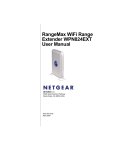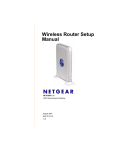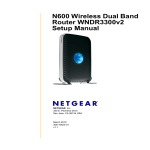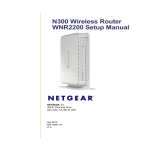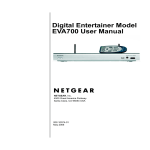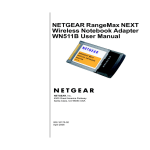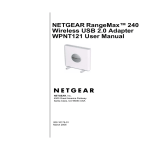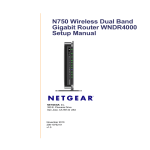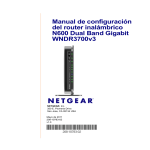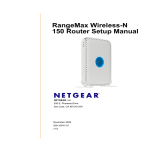Download Netgear WPN824EXT Setup Guide
Transcript
RangeMax WiFi Range Extender Setup Manual NETGEAR, Inc. 4500 Great America Parkway Santa Clara, CA 95054 USA March 2008 208-10158-02 v1.0 Trademarks NETGEAR and the NETGEAR logo are registered trademarks, and RangeMax and Smart Wizard are trademarks of NETGEAR. Inc. Microsoft, Windows, and Windows NT are registered trademarks of Microsoft Corporation. Other brand and product names are registered trademarks or trademarks of their respective holders. Statement of Conditions In the interest of improving internal design, operational function, and/or reliability, NETGEAR reserves the right to make changes to the products described in this document without notice. NETGEAR does not assume any liability that may occur due to the use or application of the product(s) or circuit layout(s) described herein. © 2008 by NETGEAR, Inc. All rights reserved. ii Contents Getting to Know Your WiFi Range Extender ....................................................................... 1 Unpacking Your New WiFi Range Extender ...................................................................... 1 Extender Front Panel ......................................................................................................... 3 Extender Back Panel ......................................................................................................... 4 Bottom Label ..................................................................................................................... 5 Installing Your WiFi Range Extender Using the Resource CD........................................... 7 About the Smart Wizard .................................................................................................... 7 Optimizing Performance after Installation .......................................................................... 9 Installing Your WiFi Range Extender Manually ................................................................ 11 Connecting Your WiFi Range Extender .......................................................................... 11 Verifying Your Connection ............................................................................................... 16 Completing Manual Setup ............................................................................................... 16 Accessing Your RangeMax WiFi Range Extender after Installation................................ 17 Logging In ........................................................................................................................ 17 Setting Up Wireless Connectivity and Enabling Wireless Security .................................. 18 Updating Your Firmware .................................................................................................. 20 Setting Up Your Wireless Computers .............................................................................. 22 Help with Troubleshooting .................................................................................................. 25 Basic Troubleshooting ..................................................................................................... 25 Troubleshooting Connectivity Using the Ping Utility ........................................................ 31 Default Configuration .......................................................................................................... 33 Default Configuration Settings ......................................................................................... 33 Restoring the Default User Name and Password ............................................................ 36 Related Documents.............................................................................................................. 37 Contents iii iv Contents Getting to Know Your WiFi Range Extender Congratulations on your purchase of the NETGEAR® RangeMax WiFi Range Extender WPN824EXT. Before you begin installing your extender, check the package contents (see Unpacking Your New WiFi Range Extender). Become familiar with the front and back panels of your extender— especially the status lights—and the important information on the extender label (see “Bottom Label” on page 5). Unpacking Your New WiFi Range Extender The product package should contain the following items: • The WiFi range extender • A snap-on stand for your WiFi range extender • An AC power adapter (varies by region) • A yellow Ethernet cable • A blue Ethernet cable • The Resource CD, which includes: • – The Smart Wizard Installation Assistant (Autorun.exe) – A PDF version of this manual – A link to the online User Manual Warranty and Support Information cards If any of the parts are incorrect, missing, or damaged, contact your NETGEAR dealer. Keep the carton, including the original packing materials, in case you need to return the product for repair. To prepare your extender for installation: 1. Carefully peel off the protective film covering the sides of your extender. Getting to Know Your WiFi Range Extender v1.0, March 2008 1 RangeMax WiFi Range Extender Setup Manual 2. Set up your WiFi range extender by inserting the extender into the stand supplied with your extender. Figure 1 3. Place your extender in an area suitable for installation (near an AC power outlet and accessible to the Ethernet cables for your wired computers). 2 Getting to Know Your WiFi Range Extender v1.0, March 2008 RangeMax WiFi Range Extender Setup Manual Extender Front Panel Figure 2 You can use the status lights on the front of the WiFi range extender to verify various conditions. Table 1. Status Light Descriptions Item Function Activity Description 1 Power On green solid Power is supplied to the extender. Off Power is not supplied to the extender. On One of the following is occurring: 2 Test • The unit is performing the power-on self-test diagnostic. • The restore factory settings button is being pushed to restore the factory default settings. Off One of the following is occurring: • The unit successfully completed the power-on self-test diagnostic. • The unit has completed resetting to factory default settings. • There is a wireless client associated with the extender. 3 Wireless Slow blinking There is no wireless client associated with this unit. On The wireless interface is enabled. Off The wireless interface is turned off. Blinking Data is being communicated over the wireless network. Getting to Know Your WiFi Range Extender v1.0, March 2008 3 RangeMax WiFi Range Extender Setup Manual Table 1. Status Light Descriptions (continued) Item Function Activity Description 4 Internet Amber off No Ethernet cable is connected from the extender to the gateway/ router. Amber on The Ethernet cable is connected from the extender to the gateway/ router, but no IP address has been received. Green on IP address has been received. Green blinking IP address has been received, and data is being transmitted and received. Green The LAN port has detected a 100 Mbps link with an attached device. Amber The LAN port has detected a 10 Mbps link with an attached device. 5 LAN Extender Back Panel The rear panel of the WPN824EXT extender contains the items in the list that follows the figure. 1 2 3 5 4 Figure 3 The back of the WiFi range extender includes: 1. On/off switch for the antenna dome light 2. AC power adapter outlet 3. Four local (LAN) 10/100 Mbps Ethernet ports for connecting the extender to local computers 4. Internet port for connecting the extender to a cable or DSL gateway/router 5. Restore factory settings button 4 Getting to Know Your WiFi Range Extender v1.0, March 2008 RangeMax WiFi Range Extender Setup Manual Top Panel Figure 4 The top of the WiFi range extender includes a dome with status lights that identify which of the seven internal antennas are active. The lights flash according to the direction of the wireless signal. These status lights are off by default but can be turned on using the on/off switch (see “Extender Back Panel” on page 4). Bottom Label View the label on the bottom of the WiFi range extender to identify the serial number, port connectors, status lights, and default login information. Figure 5 Getting to Know Your WiFi Range Extender v1.0, March 2008 5 RangeMax WiFi Range Extender Setup Manual 6 Getting to Know Your WiFi Range Extender v1.0, March 2008 Installing Your WiFi Range Extender Using the Resource CD The setup procedure using the Resource CD takes about 15 minutes to complete. Before using the Smart Wizard™ on the Resource CD to set up your WiFi range extender, ensure the following: • You have a PC with Windows Vista, or Windows 2000 or Windows XP with Service Pack 2. • You have an Internet service connection through a gateway/router. • If you are setting up wireless security, you have the configuration information for your existing wireless security, such as passphrase and keys, if applicable. If you have not already done so: • Check the package contents of your extender to ensure that it is complete. • Select an optimum location for your WiFi range extender. For more information, see “Unpacking Your New WiFi Range Extender” on page 1. If you are replacing an existing WiFi range extender, disconnect it completely from your network and set it aside before starting to install your new extender. About the Smart Wizard The NETGEAR Smart Wizard guides you through the procedure to set up your WiFi range extender. Throughout the setup process, the Smart Wizard checks to ensure that steps you perform are successfully completed. NETGEAR recommends that you use the Resource CD and the NETGEAR Smart Wizard to set up your WiFi range extender. However, if you are a Macintosh or Linux user, or you wish to manually configure your extender, see “Installing Your WiFi Range Extender Manually” on page 11. Be prepared to perform these actions while using the Smart Wizard: • Powering-on the WiFi range extender. Installing Your WiFi Range Extender Using the Resource CD v1.0, March 2008 7 RangeMax WiFi Range Extender Setup Manual • Connecting the extender to the gateway/router. • Connecting your computer to the extender. • Selecting one of these options for your wireless network: • – Whether the Smart Wizard guides you in setting up your wireless network. – Whether you set up your wireless network in the extender’s browser interface. Selecting one of these options for your wireless security: – Whether the Smart Wizard guides you in setting up your wireless security. – Whether you choose to set up your wireless security at a later time. If you choose not to select a security option during installation, you can always access the extender’s user interface later to select a security option (see “Setting Up Wireless Connectivity and Enabling Wireless Security” on page 18). To install your WiFi range extender using the Smart Wizard: 1. Insert the Resource CD into your Windows PC. The CD automatically starts and detects the language that you are using on your PC. Select a different language option, if you prefer. If the CD does not automatically start, browse the CD, and double-click . 2. When the Welcome screen appears, click Setup to start the Smart Wizard. The Smart Wizard detects details about the environment you are using, such as the following: • You have a wired connection between your computer and your gateway/router equipment. The Smart Wizard guides you in the specific steps needed to connect your extender between the gateway/router and your computer. • You have a wireless connection between your computer and your gateway/router equipment. The Smart Wizard guides you in the specific steps needed to temporarily connect your computer to the extender. You can return to using a wireless connection after your setup is complete. • You have a wired connection with a fixed Internet address, or your computer is part of a domain. The Smart Wizard guides you in the specific steps needed in these conditions, before you can set up your extender. 3. Follow the instructions and prompts to complete the installation. 8 Installing Your WiFi Range Extender Using the Resource CD v1.0, March 2008 RangeMax WiFi Range Extender Setup Manual You are now connected to the Internet. If you need to configure any settings at a later time, refer to “Accessing Your RangeMax WiFi Range Extender after Installation” on page 17. Optimizing Performance after Installation The following procedures will ensure that you get optimum performance from your high-speed WiFi range extender. • For your adapter: – The wireless adapter card for each computer in your network should support the same settings as your extender (see the online User Manual for more information). – To take advantage of the RangeMax™ feature offered by your extender, use a NETGEAR RangeMax wireless adapter (an adapter that supports up to 108 Mbps). • Disable your ISP gateway/router’s wireless function. To take advantage of the performance of your high-speed WiFi range extender, you should disable your ISP gateway/router’s wireless function. For help, go to http://kbserver.netgear.com/products/WPN824EXT.asp, and click the link for your region. • Set up your network. Set up additional wireless computers in your network to access the WiFi range extender and connect to the Internet. See “Setting Up Your Wireless Computers” on page 22. • Keep your firmware updated. For information about how to check for new firmware, see “Updating Your Firmware” on page 20. Installing Your WiFi Range Extender Using the Resource CD v1.0, March 2008 9 RangeMax WiFi Range Extender Setup Manual 10 Installing Your WiFi Range Extender Using the Resource CD v1.0, March 2008 Installing Your WiFi Range Extender Manually Before manually installing and connecting your WiFi range extender, make sure that you have an Internet service connection through a gateway/router that is capable of providing a DHCP IP address (for more information, see “Make sure that the connection to your gateway/router is correct: ” on page 26). Use these manual procedures if you are an advanced user, or a user of Macintosh or Linux systems. If you have not already done so: • Check the package contents of your extender to ensure that it is complete. • Select an optimum location for your WiFi range extender. For more information, see “Unpacking Your New WiFi Range Extender” on page 1. Connecting Your WiFi Range Extender If you are replacing an existing WiFi range extender, disconnect it completely from your network and set it aside before starting to install your new extender. Installing Your WiFi Range Extender Manually 11 To connect the WiFi range extender, the computer, and the gateway/router: 1. Power on the WiFi range extender (as illustrated in Figure 6): a. Connect the power adapter cord to the back of the WiFi range extender (1). b. Plug the power adapter into a power socket (2). Your power socket may differ from the illustration (2), according to your region. Figure 6 12 Installing Your WiFi Range Extender Manually 2. Connect the WiFi range extender to the gateway/router (as illustrated in Figure 7): • Wired connection. If you have a wired connection between your computer and your gateway/router: – Locate the Ethernet cable that connects your computer to the gateway/router, and then disconnect the cable at the computer end only (1). – Connect the free end of the cable into the yellow Internet port on the back of the WiFi range extender (2). Figure 7 Installing Your WiFi Range Extender Manually 13 • Wireless connection. If you do not have a wired connection between your computer and your gateway/router (as illustrated in Figure 8): – Locate the yellow Ethernet cable that was included in your WiFi range extender package, and connect it to the yellow Internet port on the extender (2). – Connect it to the Internet port on your gateway/router (1). Figure 8 14 Installing Your WiFi Range Extender Manually 3. Connect the WiFi range extender to your desktop or laptop computer (as illustrated in Figure 9): If you have a wireless connection to your computer, you need to temporarily connect your system to the WiFi range extender in order to set up your extender and configure your wireless connection. This cable can be removed once the setup is complete. a. Locate the blue Ethernet cable that was included in your extender package, and connect the cable to a LAN port on the extender, for example, Port 4 (1). b. Connect the other end of the cable to the Ethernet port on your computer (2). Figure 9 Installing Your WiFi Range Extender Manually 15 Verifying Your Connection Verify that your extender is connected correctly by checking the WiFi range extender status lights, as described in Figure 10 and the following steps. Figure 10 To verify that your extender is connected correctly, check the following: 1. Power. The Power light should be lit. 2. Test. The Test light should be blinking (this indicates that there is no wireless device connected yet). 3. Wireless. The Wireless light should be blinking (wireless capability is enabled). 4. Internet. The Internet light should be lit (green). 5. LAN. A LAN port light should be lit for the connected computer. Green indicates that your computer is communicating at 100 Mbps; amber indicates communication at 10 Mbps. For general information about the status lights, see “Extender Front Panel” on page 3. For help if the status lights are not as described, see “Basic Functions Are Not Working” on page 26. Completing Manual Setup Since you are configuring your WiFi range extender manually, you must log in to your extender to set up your wireless security. You can also configure other settings there. See “Accessing Your RangeMax WiFi Range Extender after Installation” on page 17. For information about how to ensure the best performance from your WiFi range extender, see “Optimizing Performance after Installation” on page 9. 16 Installing Your WiFi Range Extender Manually Accessing Your RangeMax WiFi Range Extender after Installation After installing your WiFi range extender manually, you must open a browser window and log in to the extender to complete your wireless setup. If you installed using the Resource CD, you still need to log in to the WiFi range extender any time you wish to change settings. Logging In To access the extender using its login name and password: 1. Type http://www.mywifiext.net or http://www.mywifiext.com in the address field of your browser, and then press Enter. A login window similar to the one shown in Figure 11 displays. Figure 11 2. When prompted, enter admin for the extender user name and password for the extender password, both in lowercase letters. (For security reasons, the extender has its own user name and password.) The extender user name and password are not the same as any other user name or password you might use to log in to your Internet connection. 3. If you later change the user name and password from the defaults, use what you have set up. Accessing Your RangeMax WiFi Range Extender after Installation 17 If you have problems logging in, see “I Am Unable to Log In to the WiFi Range Extender” on page 28. Setting Up Wireless Connectivity and Enabling Wireless Security The Wireless Settings screen lets you set your wireless network connections and select the appropriate and optimum security options for your network and WiFi range extender. The WiFi range extender provides highly effective security options. For more information, refer to the User Manual that is available from a link on the Resource CD or by clicking the Documentation link on the main menu of your extender. If you do not configure security on your WiFi range extender, wireless security is not enabled. Indoors, computers can connect over wireless networks at a range of several hundred feet. Unlike wired network data, your wireless data transmissions can extend beyond your walls, and anyone with a compatible adapter can receive them, allowing others outside your immediate area to access your network. For more information, refer to the User Manual that is available from a link on the Resource CD or by clicking the Documentation link on the main menu of your extender. The Smart Wizard appears only at login when you first install the WiFi range extender or when it is in its factory default state (for example, if you have reset the extender to its factory default settings). To set up wireless security through the Smart Wizard: 1. Log in to the WiFi range extender (see “Logging In” on page 17). 18 Accessing Your RangeMax WiFi Range Extender after Installation The Smart Wizard configuration assistant displays. Figure 12 2. Select Yes, guide me through the options to allow the Smart Wizard to assist you with configuring your WiFi range extender to access the Internet. If you select No to set up the connection yourself, see the procedures under “To manually set up wireless connectivity and enable wireless security:” on page 19. The Smart Wizard guides you through the steps for selecting a wireless security type and then presents your settings. 3. To save your settings and complete your connection, click Apply. To manually set up wireless connectivity and enable wireless security: 1. Log in to the WiFi range extender (see “Logging In” on page 17). 2. Select Wireless Settings under Setup on the main menu. The Wireless Settings screen displays, showing the default wireless network settings for this extender. The default wireless SSID is NETGEAR_EXT. (Use the help screens or the online User Manual if you require assistance to change your wireless settings.) The service set identifier (SSID) of any wireless adapter, which is the device’s wireless network name, must match the SSID you configured in the extender. If they do not match, you will not get a wireless connection. Accessing Your RangeMax WiFi Range Extender after Installation 19 3. Select a security option: • WPA-PSK (TKIP) + WPA2-PSK (AES) or Mixed Mode. This provides the most reliable security, and is easiest to implement, but it might not be compatible with older adapters. • WPA2-PSK (AES). This provides the most reliable security compatible with my equipment. • WPA-PSK (TKIP). This provides the most reliable security compatible with my equipment. • WEP. This provides security compatible with my equipment (not recommended as reliable). • No security. I plan to set up security later through the web browser interface (not recommended). Follow the instructions in the User Manual or the WiFi range extender help screens if you need help setting up the security feature appropriate to your needs. 4. To save your settings click Apply. If you are configuring the extender from a wireless computer and you change the extender’s SSID, channel, or security settings, you will lose your wireless connection when you click Apply. You must then change your computer’s wireless settings to match the extender’s new settings. Updating Your Firmware NETGEAR is always improving the operability and features included with your extender. To make it easy for you to receive the best, most up-to-date features of your extender, NETGEAR provides a variety of methods for updating your product. • The Smart Wizard installation assistant lets you check for and install updates as part of the installation and setup activity. • The WiFi range extender includes an update feature that lets you check for and install updates. You must be logged in to the extender to use this feature. To update firmware after you have set up your extender: 1. Log in to the WiFi range extender (see “Logging In” on page 17). The Firmware Update Assistant screen displays. 20 Accessing Your RangeMax WiFi Range Extender after Installation 2. The extender automatically checks the NETGEAR database for a new firmware image file. If no new firmware version is available, the message “No New Firmware Version Available” displays. If you select Cancel, you can check for new firmware later; see “To manually check for new extender firmware:” on page 21. 3. If new firmware is available, you are directed to the new firmware version on the NETGEAR website. Click Right-click and Save to Download, and save the file to a location on your hard disk. Usually the firmware image is an .img (or .chk) file and does not need to be decompressed before you can use it to update your extender. If, however, the file is a .zip file, then the image is compressed and must be “unzipped” before you can use the file. On Windows machines, you can use the WinZip utility to unzip the file. To install the updated firmware to your extender: 1. If the Firmware Update screen does not display automatically, select Firmware Update under Management on the main menu. The Firmware Update screen then displays. 2. Click Browse and locate the unzipped firmware image that you downloaded to your PC (the file ends in .img or .chk). 3. Once you have selected the file, click Upload to send the software to the extender. The upload process takes several minutes. When the software upload process is complete, the extender restarts. Do not try to go online, turn off the extender, shut down the computer, or do anything else to the extender until the extender finishes restarting! When the Test light stops blinking, wait a few seconds more before using the extender. 4. After the extender has restarted, select WiFi Range Extender Status under Management on the main menu. Check the firmware version to verify that your extender now has the new software installed. If you selected the No radio button during installation, and want to check for new firmware later, follow the next procedure. NETGEAR recommends that you determine the firmware version currently running on your extender before you check for updates on the NETGEAR website. Then go to the NETGEAR website, and select the model number for this extender. If a later version of the firmware is available, download the firmware to your computer, and update your extender. To manually check for new extender firmware: 1. Log in to the WiFi range extender (see “Logging In” on page 17). Accessing Your RangeMax WiFi Range Extender after Installation 21 2. Select WiFi Range Extender Status under Management on the main menu on your extender interface. When the WiFi Range Extender Status screen displays, note the version number of your extender firmware. 3. Go to http://kbserver.netgear.com/products/WPN824EXT.asp and select Downloads from the menu bar. 4. From the Product Selection drop-down menu, select WPN824EXT. The Product Support page for your extender displays. 5. Under Downloads, check the most recent firmware version offered against the firmware version shown on your WiFi Range Extender Status screen. 6. If the version on the NETGEAR website is more recent, click the version number. Then, click Right-click and Save to Download, and save the file to a location on your hard disk. 7. Follow the procedure in “To install the updated firmware to your extender:” on page 21 to complete the update process. If you are unable to successfully update using these methods, refer to the online User Manual for more information. The User Manual is available through the Documentation link on the extender main menu (or through a link on the Resource CD). Setting Up Your Wireless Computers Once you have set up your WiFi range extender, you are ready to configure your wireless computers with the same settings as those you configured on the extender. For your wireless computers to work with the extender, the settings of each wireless computer must match the WiFi range extender’s settings exactly. To set up your computers for wireless connectivity: 1. Program the wireless adapter of each computer to have the same SSID (wireless network name) as the WiFi range extender. 2. Check that the wireless adapter on each wireless computer can support the Mode and Security options that you selected. (If you have a question, see the online User Manual or review the settings you selected in “Setting Up Wireless Connectivity and Enabling Wireless Security” on page 18). 22 Accessing Your RangeMax WiFi Range Extender after Installation To ensure optimum performance of your high-speed WiFi range extender, NETGEAR recommends that the wireless adapter card for each computer in your network supports the same settings as your extender (see the online User Manual for more information). 3. Check that the security settings on each wireless device match the security settings of the extender. For example, if you selected a security option requiring a passphrase, then the same passphrase must be used for each wireless computer. 4. Check that each wireless computer has a wireless link and is able to obtain an IP address by DHCP from the gateway/router. For a Windows PC, go to the Control Panel, and select Network Connections. Check the Wireless Connections properties, and ensure that Internet Protocol (TCP/IP) properties are set to Obtain an IP address automatically. Accessing Your RangeMax WiFi Range Extender after Installation 23 24 Accessing Your RangeMax WiFi Range Extender after Installation Help with Troubleshooting This chapter gives information about troubleshooting your WiFi range extender. You can find help with the following problems: • • Basic troubleshooting – “Common Things That Can Go Wrong” – “Basic Functions Are Not Working” on page 26 – “I Am Unable to Log In to the WiFi Range Extender” on page 28 – “The Internet Service Connection Is Not Working” on page 28 – “My Wireless Performance Is Poor” on page 30 – “I Need to Restore the Default Password and Configuration Settings” on page 30 Advanced connectivity troubleshooting using the ping utility – “Testing the Path from a PC to Your Extender” on page 31 – “Testing the Path from a PC to the Internet” on page 32 Basic Troubleshooting Here are some tips for correcting simple problems you might have. Common Things That Can Go Wrong Verify that you do not have these common problems. Make sure that the Ethernet cables are securely plugged in: 1. Verify that the Internet status light on the WiFi range extender is lit if the Ethernet cable to the WiFi range extender from the gateway/router is plugged in securely and the gateway/router and WiFi range extender are both turned on (see “Extender Front Panel” on page 3). 2. Verify that for each powered-on computer connected to the WiFi range extender with a securely plugged in Ethernet cable, the corresponding WiFi range extender LAN port status light is lit (see “Extender Front Panel” on page 3). The label on the bottom of the WiFi range extender identifies the number of each LAN port (see “Bottom Label” on page 5). Help with Troubleshooting 25 v1.0, March 2008 RangeMax WiFi Range Extender Setup Manual Make sure that the connection to your gateway/router is correct: 1. Verify that you have located the correct Ethernet port for your gateway/router. 2. Verify that a DHCP server is activated for your gateway/router. 3. Verify that you have deactivated the Wi-Fi function on your gateway/router, so you can use the Wi-Fi function of the WiFi range extender. For help with deactivation, go to http:// kbserver.netgear.com/products/WPN824EXT.asp, and click the link for your region. Make sure that your computer has Internet access through your gateway/router: Verify that your LAN-connected computers have a valid Internet connection. 1. If you cannot connect to the WiFi range extender, check the Internet Protocol (TCP/IP) properties in the Network Connections section of your Control Panel. They should be set to obtain both IP and DNS server addresses automatically. 2. See “Related Documents” on page 37. Basic Functions Are Not Working After you turn on power to the extender, check these status lights: 1. When power is first applied, verify that the Power light is on. a. Make sure that the power cord is properly connected to your extender and that the power supply adapter is properly connected to a functioning power outlet. b. Check that you are using the power adapter supplied by NETGEAR for this product. If the Power light does not turn solid green within 2 minutes after you turn the extender on, reset the extender according to the instructions in “I Need to Restore the Default Password and Configuration Settings” on page 30. If the error persists, you have a hardware problem and should contact Technical Support. 3. Verify that the Test light lights within a few seconds, indicating that the self-test procedure is running. 4. After approximately 20 seconds, verify the following: a. The Test light turned off. 26 Help with Troubleshooting v1.0, March 2008 RangeMax WiFi Range Extender Setup Manual If the Test light does not turn off but instead blinks continuously, and there is no wireless client associated to the extender, this is normal. However, it should not blink continuously if at least one wireless device (such as a computer) is supposed to be associated with the extender. You should check your wireless device to make sure that it is connected to the extender’s service set identifier (SSID) that you set up (see “Setting Up Wireless Connectivity and Enabling Wireless Security” on page 18). b. The LAN port lights are lit for any local ports that are connected. c. The Internet port is connected and its light is lit. If a port’s light is lit, a link has been established to the connected device. If a LAN port is connected to a 100 Mbps device, verify that the port’s light is green. If the port is 10 Mbps, the light is amber. For more information about the status lights, see “Extender Front Panel” on page 3. Verify whether the Test light never turns on or stays on: 1. Verify that when the extender is turned on, the Test light turns on for about 20 seconds and then turns off. If the Test light does not turn on or stays on, the extender has a problem. 2. Turn the power off and then on to see if the extender recovers. If all lights including the Test light are still on 1 minute after powering up: a. Turn the power off and back on to see if the extender recovers. b. Clear the extender’s configuration to factory defaults. This sets the extender’s IP address to 192.168.1.250. This procedure is explained in “I Need to Restore the Default Password and Configuration Settings” on page 30. If the error persists, you might have a hardware problem and should contact Technical Support. Verify if the LAN or Internet port lights are not on when the Ethernet connection is made: 1. Make sure that the Ethernet cable connections are correct between the extender and the gateway/router. 2. Make sure that the Ethernet cable connections are secure at the extender and at the computer. 3. Make sure that power is turned on to the connected computer. 4. Make sure that you are using Ethernet cables like the cable that was supplied with the WiFi range extender. Help with Troubleshooting 27 v1.0, March 2008 RangeMax WiFi Range Extender Setup Manual 5. Make sure that your gateway/router is functional and has Internet access. I Am Unable to Log In to the WiFi Range Extender If you are unable to log in to the WiFi range extender, check the following: • If you are using an Ethernet-connected computer, check the Ethernet connection between the computer and the extender as described in the previous section. • If you have an Internet connection to the WiFi range extender, you can enter either of these addresses to connect: http://www.mywifiext.net or http://www.mywifiext.com. • If there is no Internet connection to the extender, you can connect your computer to the extender, then open a Web browser on your computer and connect to http://192.168.1.250. • Make sure that you are using the correct login information. The factory default login name is admin, and the password is password. Make sure that Caps Lock is off when you enter this information. • Typically, your computer’s address should be in the range of 192.168.1.2 to 192.168.1.254. Refer to your computer’s documentation for help with finding your computer’s IP address. If your computer’s IP address is 169.254.x.x, verify that you have a good connection from the computer to the extender, and then restart your computer. • Make sure that your browser has Java, JavaScript, or ActiveX enabled. If you are using Internet Explorer, click Refresh to be sure that the Java applet is loaded. Try closing the browser and starting it again. The Internet Service Connection Is Not Working If your WiFi range extender is unable to access the Internet, check that the Internet connection is working, and then check that the WiFi range extender can get an Internet address. 28 Help with Troubleshooting v1.0, March 2008 RangeMax WiFi Range Extender Setup Manual To check that the Internet connection is working: 1. Internet connection. First verify that your gateway/router has a successful connection. The gateway/router status lights indicate if the gateway/router connection is successful or not. Check your gateway/router documentation, or call your Internet Service Provider for help with verifying that the gateway/router has a successful connection. 2. Wireless range extender Internet light is off. If the Internet light is off, verify that the Ethernet cable is securely connected to the gateway/router, and that both the gateway/router and WiFi range extender are turned on. 3. Wireless range extender Internet light is green or blinking green. If your Internet light is green or blinking green, then you have a good Internet connection, and your wiring is correct. 4. Wireless range extender Internet light is amber. If your Internet light is amber, then your WiFi range extender has a successful connection to your gateway/router, but no IP address has been received. The Internet light should turn green within several minutes. If these methods do not solve the problem, see “Obtaining an Internet IP Address” or “Troubleshooting Connectivity Using the Ping Utility” on page 31. Obtaining an Internet IP Address If your Internet light is amber or blinking amber, check the WiFi range extender to see if it is able to get an Internet IP address from your service provider. Unless you have a fixed Internet address, your WiFi range extender automatically requests an IP address through a DHCP server from your service provider. To check the Internet IP address from the browser interface: 1. Log in to the WiFi range extender. 2. Select WiFi Range Extender Status under Management on the main menu to check that an IP address is shown for the Internet port. If 0.0.0.0 is shown, your WiFi range extender has not obtained an IP address from your gateway/router. Troubleshooting Internet Browsing If your WiFi range extender can obtain an IP address but your computer is unable to load any Web pages from the Internet: 1. Restart the computer. 2. Check all cable connections. Help with Troubleshooting 29 v1.0, March 2008 RangeMax WiFi Range Extender Setup Manual 3. Verify that the WiFi range extender address (192.168.1.250) is listed by your computer as the default gateway/router address. The factory default WiFi range extender address is 192.168.1.250. However, if the extender detects a conflict with the address it gets from your gateway/router, it automatically picks a different address for itself. In this case, you can log in to the extender using www.mywifiext.net to verify its LAN IP address. Select LAN IP Setup under Advanced on the main menu. Take note of the LAN TCP/IP setup IP address, which should match the default gateway/router IP address on your computer. My Wireless Performance Is Poor If your wireless performance is poor, there are several potential causes. To improve poor performance: 1. Verify that you have disabled your ISP gateway/router/router’s wireless feature (for help, go to http://kbserver.netgear.com/products/WPN824EXT.asp, and click the link for your region). 2. Verify that your device is associated with the WiFi range extender. The Test light blinks slowly if there is no wireless client associated with the extender. I Need to Restore the Default Password and Configuration Settings This section explains how to restore the factory default configuration settings, changing the extender’s administration password to password and the IP address to 192.168.1.250. This procedure will erase all the current configuration settings and restore the factory defaults. To restore the factory default configuration settings, use the restore factory settings button on the rear panel of the extender: 1. Use a sharp object like a pen or a paper clip to press and hold the restore factory settings button for about 20 seconds (see “Extender Back Panel” on page 4), until the Test light on the front turns on. 2. Release the restore factory settings button, and wait for the extender to restart. 30 Help with Troubleshooting v1.0, March 2008 RangeMax WiFi Range Extender Setup Manual Troubleshooting Connectivity Using the Ping Utility Most computers and extenders have a diagnostic utility called ping that sends a request to a target device. The device then replies. The ping utility makes it easy to troubleshoot a network. This section includes advanced troubleshooting techniques. Testing the Path from a PC to Your Extender You can ping the WiFi range extender to verify that the LAN path from your computer to your extender is set up correctly. 1. From the Windows toolbar, click Start, and select Run. 2. In the field provided, type ping followed by the address of the extender, as in this example: ping www.mywifiext.net or ping 192.168.1.250 3. Click OK. You should see a message like this one: Pinging 192.168.1.250 with 32 bytes of data If the path is working, you see this message: Reply from 192.168.1.250: bytes=32 time=NN ms TTL=xxx If the path is not working, you see this message: Request timed out If the path is not functioning correctly, you could have one of the following problems: • Wrong physical connections – • Make sure that the LAN port light is on. If the light is off, follow the instructions in “Verify if the LAN or Internet port lights are not on when the Ethernet connection is made:” on page 27. – Check that the corresponding lights are on for your computer’s network interface card. Wrong network configuration Help with Troubleshooting 31 v1.0, March 2008 RangeMax WiFi Range Extender Setup Manual – Verify that the Ethernet card driver software and TCP/IP software are both installed and configured on your computer. – Verify that the IP address for your extender and your computer are correct and that the addresses on both begin with 192.168.1. Testing the Path from a PC to the Internet After verifying that the path between your computer and the WiFi range extender works correctly, test the path from your PC to the Internet. 1. From the Windows toolbar, click Start, and select Run. 2. In the field provided, type: ping -n 10 <IP address> where <IP address> is the IP address of a remote device such as your ISP’s DNS server. If the path is functioning correctly, replies as in the previous section display. If you do not receive replies: • Make sure that the gateway/router has Internet access, and check whether other clients that are connected with the gateway/router are functioning correctly. • Check that your PC has the IP address of your gateway/router listed as the default gateway/ router. 32 Help with Troubleshooting v1.0, March 2008 Default Configuration Default Configuration Settings This section provides factory default settings and technical specifications for the RangeMax WiFi Range Extender WPN824EXT. Table 2. RangeMax WiFi Range Extender Default Configuration Settings Feature Default Setting Smart Wizard Enabled Extender Login Extender Login URL http://www. mywifiext.net or http://www.mywifiext.com Login Name (case-sensitive) printed on product label admin Login Password (case-sensitive) printed on product label password Internet Connection MAC Address Use default hardware address Local Network Extender LAN IP address printed on product label (also known as gateway/ router IP address) 192.168.1.250 Extender Subnet 255.255.255.0 DHCP Server Enabled Time Zone (GMT) Greenwich Mean Time Time Zone Adjusted for Daylight Saving Time Enabled Default Configuration 33 v1.0, March 2008 RangeMax WiFi Range Extender Setup Manual Table 2. RangeMax WiFi Range Extender Default Configuration Settings (continued) Feature Default Setting Wireless Wireless Communication Enabled SSID Name NETGEAR_EXT Security Disabled Broadcast SSID Enabled Transmission Speed Autoa Country/Region United States in the U.S., otherwise varies by region RF Channel Auto Operating Mode 802.11 g/b Data Rate Best Output Power Full a. Maximum wireless signal rate derived from IEEE Standard 802.11 specifications. Actual throughput will vary. Network conditions and environmental factors, including volume of network traffic, building materials and construction, and network overhead, lower actual data throughput rate. Network Protocol and Standards Compatibility Data and Routing Protocols TCP/IP, DHCP Power Adapter North America 120V, 60 Hz, input United Kingdom, Australia 240V, 50 Hz, input Europe 230V, 50 Hz, input Japan 100V, 50/60 Hz, input All regions (output) 12 V DC @ 1A output, 22W maximum Physical Specifications Dimensions 28 x 175 x 119 mm (1.1 x 6.89 x 4.68 in.) Weight 0.3 kg (0.66 lb) Environmental Specifications Operating temperature 0° to 40° C Operating humidity 90% maximum relative humidity, noncondensing 34 (32º to 104º F) Default Configuration v1.0, March 2008 RangeMax WiFi Range Extender Setup Manual Table 2. RangeMax WiFi Range Extender Default Configuration Settings (continued) Feature Default Setting Electromagnetic Emissions Meets requirements of FCC Part 15 Class B VCCI Class B EN 55 022 (CISPR 22), Class B C-Tick N10947 Interface Specifications LAN 10BASE-T or 100BASE-Tx, RJ-45 Internet 10BASE-T or 100BASE-Tx, RJ-45 Wireless Maximum wireless signal rate complies with the IEEE 802.11 standard. Actual throughput will vary. Network conditions and environmental factors, including volume of network traffic, building materials and construction, and network overhead, lower actual data throughput rate. Radio Data Rates 1, 2, 5.5, 6, 9, 12, 18, 24, 36, 48, 54, and 108 Mbps Auto Rate Sensing Frequency Data Encoding 2.4–2.5 Ghz 802.11b: Direct Sequence Spread Spectrum (DSSS) 802.11g: Orthogonal Frequency Division Multiplexing (OFDM) Maximum Computers Per Wireless Network Limited by the amount of wireless network traffic generated by each node. Typically 30-70 nodes. Operating Frequency Ranges 2.412–2.462 GHz (US) 2.457–2.462 GHz (Spain) 2.412–2.484 GHz (Japan) 2.457–2.472 GHz (France) 2.412–2.472 GHz (Europe ETSI) 802.11 Security 40-bit (also called 64-bit) and 128-bit WEP, WPAPSK and WPA2-PSK. Default Configuration 35 v1.0, March 2008 RangeMax WiFi Range Extender Setup Manual Restoring the Default User Name and Password You can restore the factory default configuration settings that reset the extender’s user name to admin, the password to password, and the IP address to 192.168.1.250. This procedure erases your current configuration, including your wireless security settings, and restores the factory defaults. When you log in after resetting, the Smart Wizard configuration assistant prompts you to configure these settings. To restore the factory default configuration settings: 1. Use a sharp object such as a pen or a paper clip to press and hold the restore factory settings button, located on the rear panel of the extender, for about 20 seconds (see “Extender Back Panel” on page 4). 2. Release the restore factory settings button and wait for the extender to reboot. The factory default settings are restored so that you can access the extender from your web browser using the factory defaults. 36 Default Configuration v1.0, March 2008 Related Documents This table provides links to reference documents you can use to gain a more complete understanding of the technologies used in your NETGEAR product. Table 3. Reference Documents Document Link TCP/IP Networking Basics http://documentation.netgear.com/reference/enu/tcpip/index.htm Preparing Your Network http://documentation.netgear.com/reference/enu/wsdhcp/index.htm Glossary http://documentation.netgear.com/reference/enu/glossary/index.htm Related Documents 37 v1.0, March 2008 RangeMax WiFi Range Extender Setup Manual 38 Related Documents v1.0, March 2008 Registration and Certifications Product Registration, Support, and Documentation Register your product at http://www.NETGEAR.com/register. You must register before you can use our telephone support service. Product updates and Web support are always available by going to: http://www.NETGEAR.com/support. Setup documentation is available on the CD, on the support website, and on the documentation website. When the WiFi range extender is connected to the Internet, click the KnowledgeBase link to view support information, or click the Documentation link to view the online User Manual for this WiFi range extender. Maximum Wireless Signal Rate Derived from IEEE Standard 802.11 Specifications Actual data throughput will vary. Network conditions and environmental factors, including volume of network traffic, building materials and construction, and network overhead, lower actual data throughput rate. Federal Communications Commission (FCC) Compliance Notice: Radio Frequency Notice This equipment has been tested and found to comply with the limits for a Class B digital device, pursuant to Part 15 of the FCC Rules. These limits are designed to provide reasonable protection against harmful interference in a residential installation. This equipment generates, uses, and can radiate radio frequency energy and, if not installed and used in accordance with the instructions, may cause harmful interference to radio communications. However, there is no guarantee that interference will not occur in a particular installation. If this equipment does cause harmful interference to radio or television reception, which can be determined by turning the equipment off and on, the user is encouraged to try to correct the interference by one or more of the following measures: • Reorient or relocate the receiving antenna. • Increase the separation between the equipment and receiver. • Connect the equipment into an outlet on a circuit different from that to which the receiver is connected. • Consult the dealer or an experienced radio/TV technician for help. 39 40












































